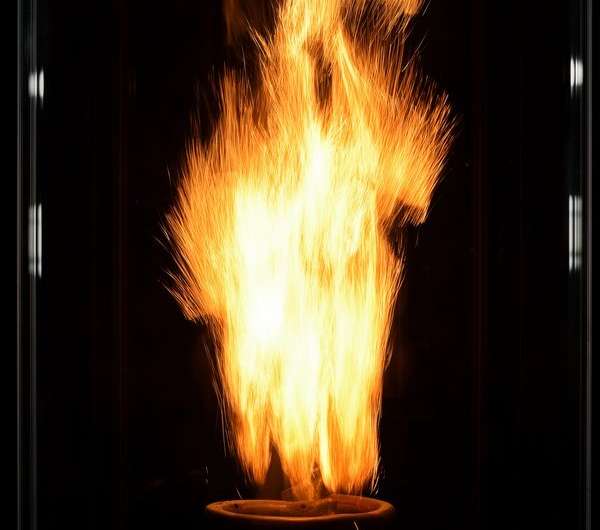This article has been reviewed according to Science X's editorial process and policies. Editors have highlighted the following attributes while ensuring the content's credibility:
fact-checked
trusted source
proofread
Pursuing metal fuel for carbon-free energy on Earth and the moon

Everything burns. Given the right environment, all matter can burn by adding oxygen, but finding the right mix and generating enough heat makes some materials combust more easily than others. Researchers interested in knowing more about a type of fire called discrete burning used ESA's microgravity experiment facilities to investigate.
In a series of parabolic flights and on sounding rockets launched from Sweden, a team from Professor Jeffrey Bergthorson at McGill University in Canada and Eindhoven University of Technology in The Netherlands investigated burning iron powder in zero gravity. Their research was pure physics, the scientists wanted to know more about discrete burning whereby flames do not burn through fuel continuously but jump from one fuel source to another.
This form of fire hardly occurs naturally on Earth, but an example is a forest fire where one tree burns completely and the fire jumps to the next tree when the temperature increases enough for combustion.
Burning iron dust in experiments on zero-g aircraft and rocket flights allowed for the iron particles to float and ignite discreetly. High-speed cameras captured the spectacle and allowed the researchers to better understand the phenomenon, resulting in computer models that showed the ideal conditions to burn the fuel on Earth.
Discrete burning for sustainable energy
With the new understanding made possible from microgravity research it became possible to build efficient and practical iron-burning furnaces.
The advantage of burning iron is down to chemistry. Essentially, burning fuel is the process of transforming a material by adding oxygen atoms. his is why carbon-based fuel produces the greenhouse gas carbon dioxide when two oxygen atoms are added to the carbon-based fuel such as wood, coal or oil. With iron, the leftover product after combustion is iron oxide, more commonly known as rust. No carbon dioxide is produced, and the rusty iron can be easily collected as it doesn't form a gas—burning iron emits no noxious gases at all.
Iron rust can even be processed to remove the oxygen and return it as iron using hydrogen. By using electricity from sustainable sources, iron as a fuel can become a circular, endlessly recyclable energy storage.
A demonstration plant is already up and running in Budel, near Eindhoven, The Netherlands, using iron as its fuel source this generator can produce 1 MW of steam in a unit that stands in a warehouse. Scaled up such an iron power plant could produce much more energy.
Multiple start-ups are already pursuing this carbon-free fuel, to power factories and industrial processes.
From space to Earth and then to the moon
As space agencies prepare to build sustainable lunar outposts, supplying energy for the astronauts on the moon is just one of the challenges to overcome. Metal fuel could be a solution. Using solar energy, not only aluminum and silicon powders can be produced from lunar minerals, but also hydrogen and oxygen can be harnessed from lunar ice.
The hydrogen can then be used to convert lunar dust that is high in iron and titanium to produce water and iron powder. The metallic powders and oxygen from the water ice can be used as propellants for rockets or ground transportation and the water by product can even be used as drinking water.
This process might seem like science fiction now but using iron as a fuel source on Earth started out as an idea just a decade ago. Now the metal fuel community spans hundreds of scientists and engineers around the globe and is a lighthouse technology for alternative carbon-free fuel. In a not-so-distant future you might be running your car or home on iron.
















